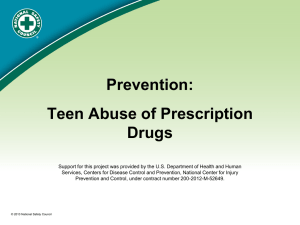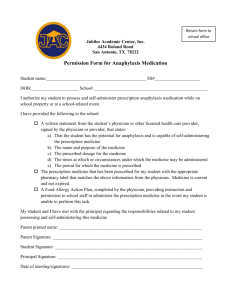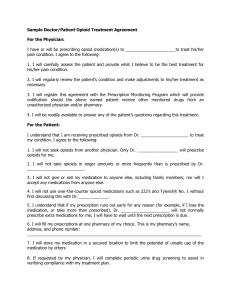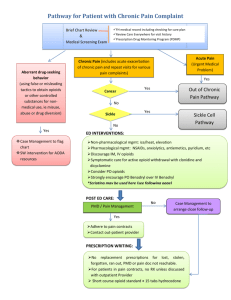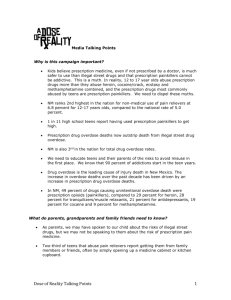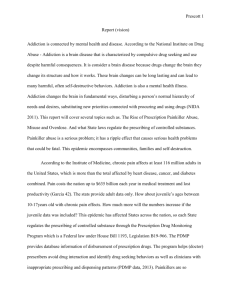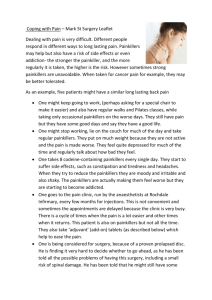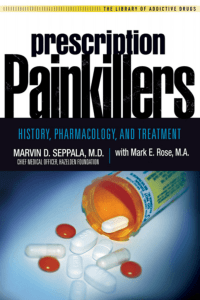File
advertisement
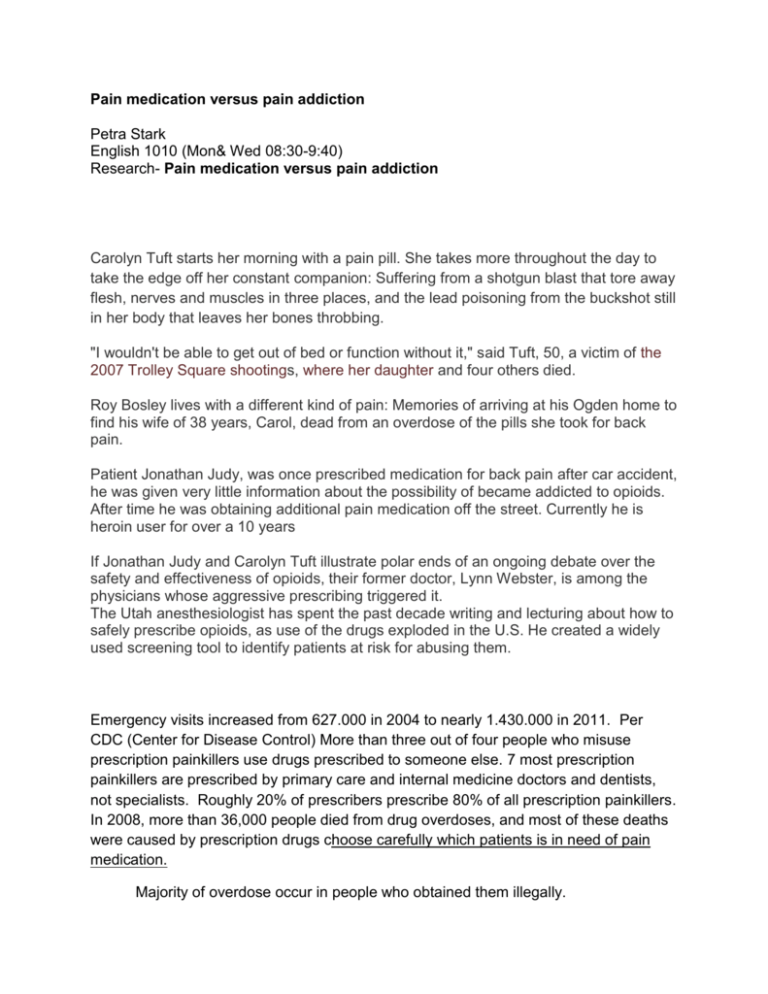
Pain medication versus pain addiction Petra Stark English 1010 (Mon& Wed 08:30-9:40) Research- Pain medication versus pain addiction Carolyn Tuft starts her morning with a pain pill. She takes more throughout the day to take the edge off her constant companion: Suffering from a shotgun blast that tore away flesh, nerves and muscles in three places, and the lead poisoning from the buckshot still in her body that leaves her bones throbbing. "I wouldn't be able to get out of bed or function without it," said Tuft, 50, a victim of the 2007 Trolley Square shootings, where her daughter and four others died. Roy Bosley lives with a different kind of pain: Memories of arriving at his Ogden home to find his wife of 38 years, Carol, dead from an overdose of the pills she took for back pain. Patient Jonathan Judy, was once prescribed medication for back pain after car accident, he was given very little information about the possibility of became addicted to opioids. After time he was obtaining additional pain medication off the street. Currently he is heroin user for over a 10 years If Jonathan Judy and Carolyn Tuft illustrate polar ends of an ongoing debate over the safety and effectiveness of opioids, their former doctor, Lynn Webster, is among the physicians whose aggressive prescribing triggered it. The Utah anesthesiologist has spent the past decade writing and lecturing about how to safely prescribe opioids, as use of the drugs exploded in the U.S. He created a widely used screening tool to identify patients at risk for abusing them. Emergency visits increased from 627.000 in 2004 to nearly 1.430.000 in 2011. Per CDC (Center for Disease Control) More than three out of four people who misuse prescription painkillers use drugs prescribed to someone else. 7 most prescription painkillers are prescribed by primary care and internal medicine doctors and dentists, not specialists. Roughly 20% of prescribers prescribe 80% of all prescription painkillers. In 2008, more than 36,000 people died from drug overdoses, and most of these deaths were caused by prescription drugs choose carefully which patients is in need of pain medication. Majority of overdose occur in people who obtained them illegally. Safely prescribed pain medication Dr. Webster is presenting guideline which he developed. For easy recall he summed them into acronym RELIABLE – Respiratory, Experience, Long term, Initiating methadone, Apnea, Benzodiazepines, Look for comorbidities, Experience caution with switching. I believe it is important to know patient family background and substance abuse history, to determent to potential for misuse. I have meet several patient that started use medication because they were easy to get from home medicine cabinet. Yes, cause/effect was implied by the author. He is emphasizing the problem that was once quoted as epidemic of overdose deaths from prescription drugs. How to prevent opioid addiction and misuse The academy and other physician groups "understated the risks and overstated the benefits" of narcotic pain killers, fueling a dramatic rise in opioid prescriptions and overdose deaths, said Korff. But there's no evidence these drugs are effective at managing chronic pain and medical opinion is changing. "These are treatments that should be used selectively, with great caution and at low doses." Webster concedes, "Opioids are not the best treatment for many people." There aren't enough long-term studies to show what subset of the population benefits, he said. But currently, he said, there's no substitute for the "many people who simply could not live unless they had strong pain relievers." Patients need to be warned of the dangers, but if patient take too much, more than prescribed, that's their fault, not the doctor's. As a society, we must care for the millions of people who suffer from pain, while preventing those same patients from ending their lives by overusing their medications. Dr. Webster is one of the most highly respected physicians in the field and has worked tirelessly to prevent the overprescribing and misuse of opioids as part of a pain treatment regimen.” Dr. Webster is introducing information on how to safely prescribed opioids medication. He is concern about increasing number of abuse/misused of prescribed drug and mostly about unintentional overdose deaths. Patients can also be treated with psychological therapies, as well as physical and occupational therapy, he says. Many patients, however, do not receive a multidisciplinary approach to treating chronic pain because it generally requires the resources of an academic medical center. Doctors who are treating patients without these resources need to collaborate with others who have the knowledge they don’t, either in addiction medicine or pain medicine. Almost all prescription drugs involved in overdoses come from prescriptions originally; very few come from pharmacy theft. However, once they are prescribed and dispensed, prescription drugs are frequently diverted to people using them without prescriptions. More than three out of four people who misuse prescription painkillers use drugs prescribed to someone else.7 Most prescription painkillers are prescribed by primary care and internal medicine doctors and dentists, not specialists.10 Roughly 20% of prescribers prescribe 80% of all prescription painkillers. 100 people die from drug overdoses every day in the United States.4 Annotated Bibliography Los Angeles Times, Girion, Lisa, and Melissa Healy "Responding to calls to stem a growing epidemic of prescription drug addiction and overdose deaths, federal officials are urging doctors to reserve the most powerful pain drugs for patients who need long-term, around-the-clock treatment that can't be managed by other means. Leaders of the Food and Drug Administration said they hoped new drug labeling guidelines unveiled Tuesday [Sept. 11, 2013] would prompt doctors to be more cautious in prescribing long-acting and extended-release forms of oxycodone, morphine and other narcotic painkillers, known as opioids." (Los Angeles Times) This article discusses the FDA's action to require stricter labels for opioid painkillers. The "FDA will now require the manufacturers of 20 long-acting opioid products to rewrite the drugs' labels to reflect that they should be used more sparingly." Milwaukee Journal Sentinel, Fauber, John, Feb 19, 2012 "Prescriptions for narcotic painkillers soared so much over the last decade that by 2010 enough were being dispensed to medicate every adult in the United States around the clock for a month. Behind that surge was a network of pain organizations, doctors and researchers that pushed for expanded use of the drugs while taking in millions of dollars from the companies that made them, a Milwaukee Journal Sentinel/MedPage Today investigation found." (Milwaukee Journal Sentinel) This article discusses how the pharmaceutical industry has influenced the "practice of pain medicine." CDC (Center for Disease Control), Jun 30, 2011 Emergency visits summary. Graph Michael Von Korff, an epidemiologist in Seattle and a member of Physicians for Responsible Opioid Prescribing, Sept,2013 Webster LR, Dove B. Avoiding Opioid Abuse While Managing Pain: A Guide for Practitioners, 2007 This book was written to help all interested parties (eg, clinicians who treat pain, drug and medical-practice regulators, law-enforcement authorities and pharmacists) to sort out the clinical, regulatory, and ethical issues associated with the prescribing of Opioids. Prescription Drugs Abuse and Addiction; National Institute on Drug Abuse (NIDA) Summary: This site examines "the non-medical use of prescription drugs-opioids, central nervous system depressants, and stimulants-describing adverse health effects of their use and the prevention and treatment of addiction."(NIDA) Trends, prevention and treatment are discussed. A glossary is included.
